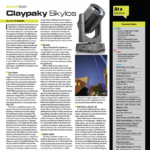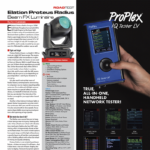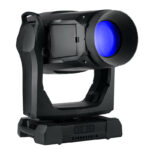Blizzard Lighting, a relative newcomer on the scene, has recently been making waves with their new lighting products. I got the chance to check out one of their recently introduced fixtures, the RokBox EXA. There’s no shortage of LED PARs on the market — just about ever manufacturer has one — so I spent a few days looking at the capabilities of their new light to see what set it apart.
A Square Face
The unit is fairly compact for an LED PAR, measuring 9 inches on the face of the fixture and just 6.5 inches deep, making fitting it into a truss as a toner a very easy task. Somewhat unusually, the fixture has a square face as opposed to the more common round casing that emulates a traditional PAR. The construction is pleasingly sturdy, very solid and all metal, except for the power connectors and the plastic tightening knobs on the double-arm yoke. These function both as an attachment point for the rigging hardware of your choice or as a stand for floor mounting. Small plastic washers come pre-installed in between the two arm yokes and the chassis of the unit, assuring smooth rotation all around. The fixture weighs about 10 pounds and has two holes on the back for a safety cable, which is not included. These holes are quite small, and an ordinary safety cable will definitely not fit through, so the end user will need to make or buy one that’s appropriately sized.
Light Source
The fixture’s source is eighteen LED packages on the face, each with six dies behind them, in red, green, blue, white, amber, and ultraviolet, for a total power loading of about 15 watts. Blizzard has contracted a private manufacturer to produce the six-in-one packages for their needs. The emitters are mounted on a small circular standoff package, with a small clear lens over them that acts as a wide-angle optic for the TIR lenses. The eighteen packages are then mounted on a single circuit board resting on a large aluminum heat sink with two fans to help dissipate all that heat. Blizzard says that the fans vary their speed depending on the needs of the fixture. In my testing, they maintained a constant speed from the time I turned the light on, but they aren’t loud to begin with. The fixture remained cool.
 Optics
Optics
Mounted above the LED packages are total internal reflection (TIR) lenses that look like clear plastic cones, with an indent in the pointy end that fits over the wide-angle lens of the LED package and combines all of the colors into a single beam and helps with homogenization and color banding, and have a 25º beam angle. They do a good job; helping to reduce the fringing that was common in the early days of LED technology. There was some banding apparent as a multi-colored shadow at normal throw distances, but it was minor and not objectionable. Personally, I am extremely glad the days of seeing a bunch of colored shadows from bare single-color LEDs are over.
 Output and Dimming
Output and Dimming
I measured the output immediately after turning all the emitters on to full, and let the fixture reach thermal equilibrium for 20 minutes, re-measured, and read no drop in output, which is an impressive achievement. The dimmer has a very nice almost linear curve, with a few very slight bumps at the top end, bumps that I would not expect to be noticeable in everyday use. Stepping was only visible during the last few clicks before blackout, and Blizzard has provided speed settings to accommodate users who need ultra-smooth dimming. (Click on chart for details.)
I measured maximum output with all emitters at full to be 6800 lux at five feet, which probably isn’t a realistic usage. I mixed a nice 5600-Kelvin white and measured at about 6300 lux, a respectably small drop in output.
Colors
Where this fixture really shines is in the six-color system, which is currently a rarity in the LED PAR market. The colors were very good, with amber being the weakest in terms of output of the bunch, and not a pleasing color on its own. (Think a low-pressure sodium vapor lamp, like the kind used to illuminate parking lots.) However, that amber helps tremendously when mixing camera-friendly shades and tints. The whites I was able to achieve with the color system all looked very good, from a nice 5600-Kelvin crisp white to a warm incandescent glow. The system also made very pleasing warm yellows with the amber emitter up, as well as a fiery orange. Blizzard has chosen to go with a blue LED instead of the deeper “royal blue” that you see in some other lights, which is something to be aware of when mixing this light with other luminaires in your rig. Further, the white especially help when mixing any sort of pastels or light shades. When measured, the output percentages of all colors combined added up to more than 100 percent, showing that Blizzard is utilizing some load sharing.
The UV is a different beast. It’s a 395-400 nm wavelength LED, and is not intended to wash the stage with visible light so much as excite phosphorescent materials on the stage. It does a good job at this, highlighting anything phosphorescent and making it vividly glow. I imagine most users will probably use the UV on its own, as the effect is very easily overpowered. However, I was able to get some delightfully weird shades when mixing the UV with just one other color. Mixed with amber, you get an eerie pinkish wash that makes white objects glow purple. Combined with red, it makes a very intense rose-like color with a deep violet tinge on whites and phosphorescent materials. This UV LED has some great potential to be used with an effects generator to create some truly interesting color chases.
Speed and Strobes
The unit has two separate speed settings, one DMX and one adjusted via the menu system. The one in the light has four settings, allowing the user to adjust the dimming speed from instant up to something that approximates the speed of an incandescent filament cooling off. With these modes activated, an instant drop to DMX value 0 on any color channel will result in a very nice smooth fade to black — and note that this will affects colors, not just the dimmer channel. A separate channel in the light allows for controlling speeds from the desk. The unit has the expected strobe setting that goes from slow to fast, though it lacks any random strobe or ramp effect functions. There’s also a nice selection of built-in color macros for fast programming, as well as a speed channel to control them.
The light is powered by a single Neutrik PowerCON and has a through for daisy chaining, and auto-senses voltage from 110V to 240V. The version I reviewed had 3-pin XLR , but Blizzard offers 5-pin DMX ports via special order. The light also supports wiCICLE wireless DMX, though my unit was a prototype and not equipped yet. A seven-segment LED display on the back allows access to menu functions.
At a Glance
Compact, Rok-Solid
The RokBox EXA enters a busy sector of the market, and will find great use in the club, DJ, and house of worship markets. The small size, UV emitter, and solid construction all contribute to what I feel is a versatile and quality product.
RokBox EXA
Pros: UV emitter is cool, good colors, tour-grade construction, extremely affordable.
Cons: No safety cable included, more strobe functions would be nice.
Price: $699.99 (MSRP)
More Info: www.blizzardlighting.com



